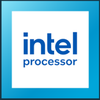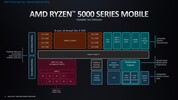Intel Processor N150 vs AMD Ryzen 7 5825U
Intel Processor N150
► remove from comparison
The Intel Processor N150 is the slowest mobile processor of the Twin Lake family. Twin Lake is mostly identical to Alder Lake-N, an architecture that will turn 4 in H2 2025. The N150 is meant for entry-level laptops, tablets and mini PCs with no fans; it offers 4 Efficient (Gracemont) cores that run at up to 3.6 GHz, but no Performance cores. Compared to the N250, the N150 has a significantly slower iGPU and slightly lower CPU clock speeds.
Gracemont E-cores do not support Hyper-Threading. No extra threads here.
Performance
Its multi-thread performance should be about as good as older dual-core CPUs like the Core i3-10110U. Exact figures depend on the cooling solution and TDP settings of the system. Either way, this is a pretty slow chip that is only just fast enough for basic tasks.
Graphics
The SoC comes equipped with a Xe-architecture graphics unit with 24 EUs (Execution Units) running at up to 1.0 GHz. The iGPU can drive up to 3 UHD 2160p monitors and hardware-decodes AV1 among other popular video codecs. Due to the low number of Xe cores and the single-channel RAM restriction, gaming performance is only good enough for very old games and low resolutions such as XGA 1024 x 768.
Architecture and Features
The integrated memory controller supports single-channel DDR4-3200, DDR5-4800 and LPDDR5-4800 RAM. PCIe NVMe SSD speeds are capped at 3.9 GB/s, corresponding to the PCIe 3 spec. There is no Thunderbolt / USB 4 support here, however, the latest Intel CNVi Wi-Fi 7 wireless networking modules are supported.
Its L3 cache is relatively small at 6 MB, and it has no proper NPU (and thus no Copilot+ branding).
Power consumption
The N150 is supposed to consume 6 watts when under longer loads. This is the Intel-recommended PL1 for the chip. No data on PL2 has been provided but values higher than 15 W are unlikely.
The SoC is manufactured using the second-generation 10 nm process marketed as Intel 7 meaning power efficiency isn't great here compared to the latest 3 nm silicon from the likes of Apple.
AMD Ryzen 7 5825U
► remove from comparison
The AMD Ryzen 7 5825U is a processor for thin and light laptops based on the Cezanne generation. It is part of the "Barcelo" refresh in early 2022 and offers 100 MHz higher clocked CPU cores compared to the old Ryzen 7 5800U. The R7 5825U integrates all eight cores based on the Zen 3 microarchitecture and is the fastest U-series processor at launch. They are clocked at 2 (guaranteed base clock) to 4.5 GHz (Turbo) and support SMT / Hyperthreading (16 threads). The chip is manufactured on the modern 7 nm TSMC process.
The new Zen 3 microarchitecture offers a significantly higher IPC (instructions per clock) compared to Zen 2. For desktop processors AMD claims 19 percent on average and in applications reviews showed around 12% gains at the same clock speed.
Performance
The average 5825U in our database is in the same league as the Ryzen 7 7735U and the Core i7-1270P, as far as multi-thread benchmark scores are concerned. Which is a really good result, as of early 2023.
Thanks to its decent cooling solution and a long-term CPU power limit of 37 W, the 2022 Envy x360 15 is among the fastest laptops built around the 5825U that we know of. It can be more than 15% faster in CPU-bound workloads than the slowest system featuring the same chip in our database, as of August 2023.
In addition to the eight CPU cores, the APU also integrates a Radeon RX Vega 8 GPU with 8 CUs at up to 2000 MHz. The dual channel memory controller supports DDR4-3200 and energy efficient LPDDR4-4266 RAM. Furthermore, 16 MB level 3 cache (up from 8 MB at the 4800U) can be found on the chip.
The TDP of the APU is specified at 15 Watt (default) and can be configured from 10 to 25 Watt by the laptop vendor (most chips are configured higher than 15 Watt). That means the chip is intended for thin and light laptops (but with fans).
| Model | Intel Processor N150 | AMD Ryzen 7 5825U | ||||||||||||||||||||||||||||||||
| Codename | Twin Lake | Barcelo-U (Zen 3) | ||||||||||||||||||||||||||||||||
| Series | Intel Alder Lake-N | AMD Cezanne (Zen 3, Ryzen 5000) | ||||||||||||||||||||||||||||||||
| Series: Cezanne (Zen 3, Ryzen 5000) Barcelo-U (Zen 3) |
|
| ||||||||||||||||||||||||||||||||
| Clock | <=3600 MHz | 2000 - 4500 MHz | ||||||||||||||||||||||||||||||||
| L3 Cache | 6 MB | 16 MB | ||||||||||||||||||||||||||||||||
| Cores / Threads | 4 / 4 4 x 3.6 GHz Intel Gracemont E-Core | 8 / 16 | ||||||||||||||||||||||||||||||||
| TDP | 6 Watt | 15 Watt | ||||||||||||||||||||||||||||||||
| Technology | 10 nm | 7 nm | ||||||||||||||||||||||||||||||||
| Socket | BGA1264 | FP6 | ||||||||||||||||||||||||||||||||
| Features | DDR4-3200/DDR5-4800/LPDDR5-4800 RAM (sin. chan.), PCIe 3, GNA, MMX, SSE, SSE2, SSE3, SSSE3, SSE4.1, SSE4.2, AVX, AVX2, BMI2, ABM, FMA, ADX, VMX, SMEP, SMAP, EIST, TM1, TM2, Turbo, SST, AES-NI, RDRAND, RDSEED, SHA | DDR4-3200/LPDDR4x-4266 RAM (incl. ECC), PCIe 3, MMX, SSE, SSE2, SSE3, SSSE3, SSE4A, SSE4.1, SSE4.2, AVX, AVX2, BMI2, ABM, FMA, ADX, SMEP, SMAP, SMT, CPB, AES-NI, RDRAND, RDSEED, SHA, SME | ||||||||||||||||||||||||||||||||
| iGPU | Intel UHD Graphics 24EUs (Alder Lake-N) ( - 1000 MHz) | AMD Radeon RX Vega 8 (Ryzen 4000/5000) ( - 2000 MHz) | ||||||||||||||||||||||||||||||||
| Architecture | x86 | x86 | ||||||||||||||||||||||||||||||||
| Announced | ||||||||||||||||||||||||||||||||||
| Manufacturer | www.intel.com | www.amd.com | ||||||||||||||||||||||||||||||||
| L1 Cache | 512 KB | |||||||||||||||||||||||||||||||||
| L2 Cache | 4 MB | |||||||||||||||||||||||||||||||||
| max. Temp. | 95 °C |
Benchmarks
Average Benchmarks Intel Processor N150 → 100% n=52
Average Benchmarks AMD Ryzen 7 5825U → 259% n=52
* Smaller numbers mean a higher performance
1 This benchmark is not used for the average calculation












